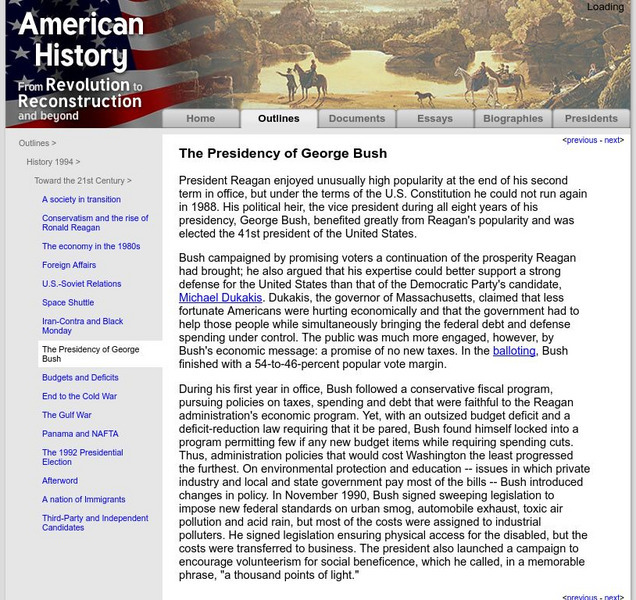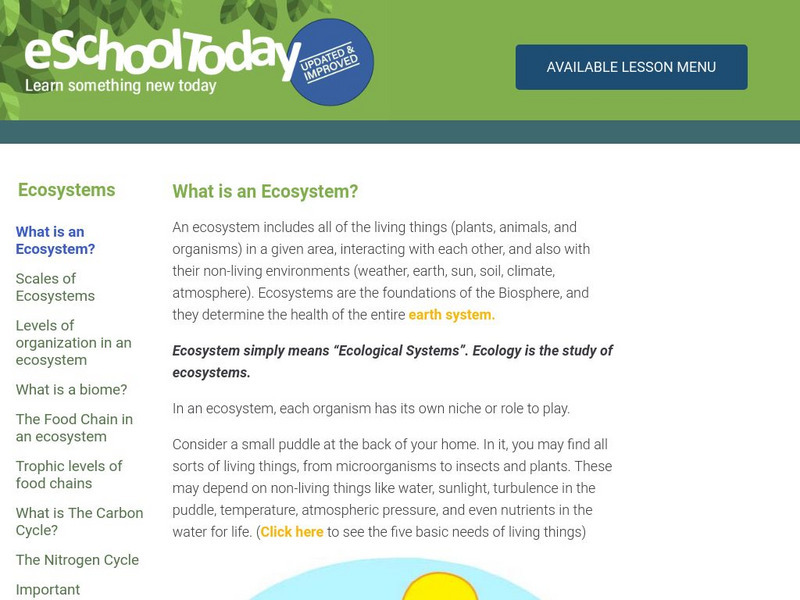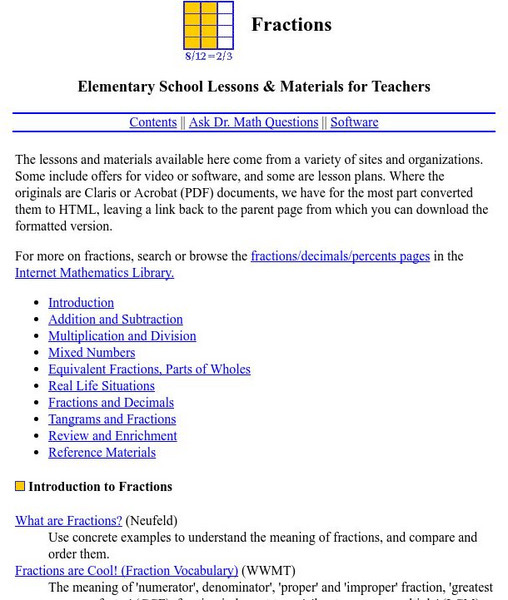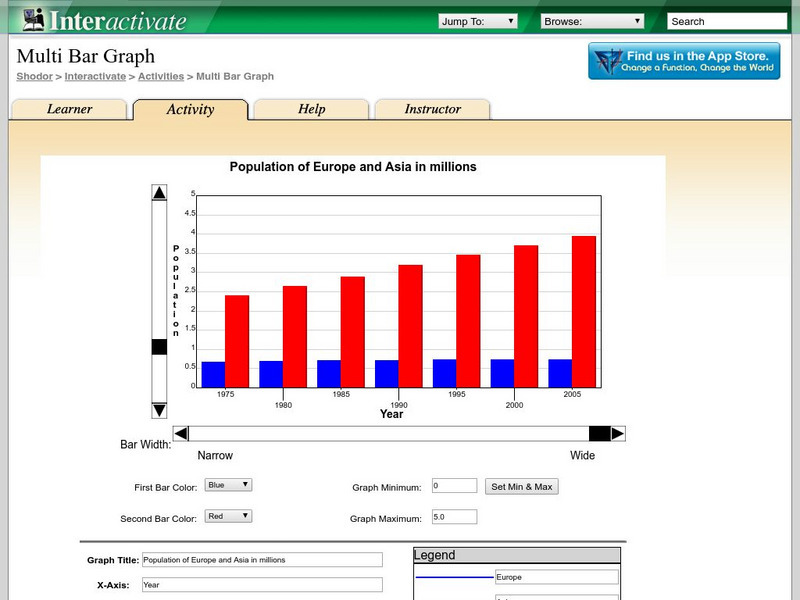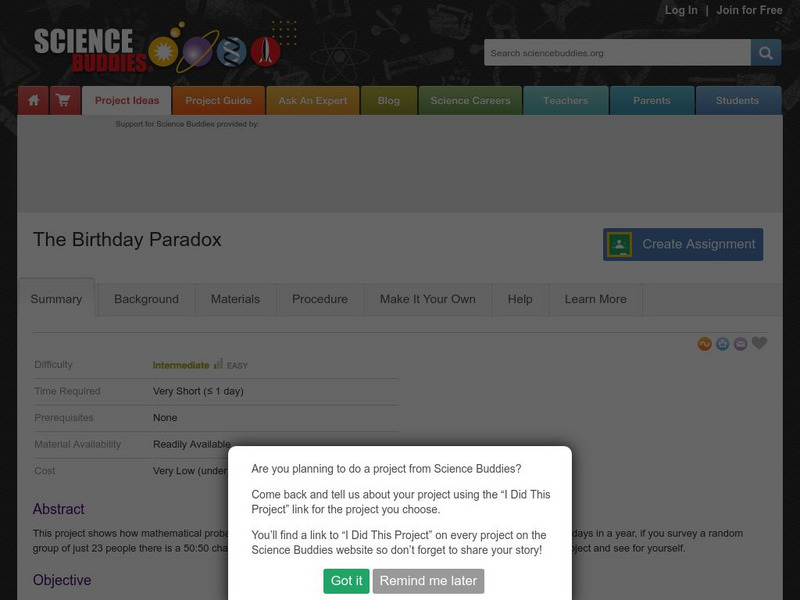Into the Outdoors
Into the Outdoors: Black Bear Biology
Presents information about the black bear. Watch the accompanying video to learn how this omnivore's adaptation allows it to survive and reproduce. Site also includes lesson plans about the black bear. [10:22]
University of Groningen
American History: Outlines: The Presidency of George Bush
This site has information about the election and presidency of George H.W. Bush. Links within the text go to other pages with information.
National Endowment for the Humanities
Neh: Edsit Ement: Eyewitness to History (Lesson Plan)
Understanding the important events in United States history and being able to recognize how history affects current events are crucial skills for learners. This lesson plan lets them examine and analyze important milestones through...
National Endowment for the Humanities
Neh: Edsit Ement: Dust Bowl Days
Seven-instructional activity collection of lessons and suggested activities for instructing early learners about the Dust Bowl using a variety of primary sources (songs, letters, photos, etc.).
National Endowment for the Humanities
Neh: Edsit Ement: Anishinabe Ojibwe Chippewa: Culture
Though written for grades 3-5, this lesson plan can be easily changed to help students of all ages learn about the Chippewa people. Additional resources provide historical, cultural, and geographical facts concerning this Native American...
NOAA
Noaa: Boat Building Challenge [Pdf]
Read to find out about the first boat builders. Construct your own boat out of common materials to explore buoyancy.
eSchool Today
E School Today: What Is an Ecosystem?
Learn about all the different levels of ecosystems, from the living things under a rock, up to a rainforest biome. Explains the levels of organization within an ecosystem, the different types of biomes, food chains and trophic levels,...
eSchool Today
E School Today: Renewable Energy Sources
Learn what renewable energy is, the different types, and why it's important to conserve energy.
eSchool Today
E School Today: Your Cool Facts and Tips on Water Pollution
Looks at water pollution, its causes and impact, what individuals and governments can do to combat it, and the process of treating wastewater.
PBS
Pbs Learning Media: The Wreck of the Corinthian
This interactive activity, adapted from material provided by the ECHO partners, tells the story of the wreck and towing of the whaling ship Corinthian using three narrative sources.
PBS
Pbs Learning Media: Buoyancy Brainteasers: Buoyancy Question
This interactive brainteaser from the NOVA: "Voyage of Doom" Web site challenges you to figure out what causes an object to sink.
PBS
Pbs Learning Media: Seeds Away
This collection of images shows several types of plant seeds, each with a different mechanism for dispersing from the parent plant.
PBS
Pbs Learning Media: How the Woodpecker Avoids a Headache
This diagram from Rainbird Publishing describes the specialized physical characteristics that allow woodpeckers to create some of the most secure nests in the bird world.
University of South Florida
Educational Technology Clearinghouse: Lit2 Go: Sara Cone Bryant: Little Daylight
Text of the fairy tale, "Little Daylight," by Sara Cone Bryant. The text can be read online or downloaded in MP3 or PDF format. In addition, the story has downloadable support material which focuses on various reading skills and strategies.
University of Alberta
Atlas of Alberta Railways: Before the Railway: Trails, Canoes and York Boats
Presented by the University of Alberta, this resource contains information on the early trade routes used in western Canada before the construction of the railway. The site also provides digital maps showing the locations of the land and...
National Council of Teachers of Mathematics
The Math Forum: Lesson Plans: Fractions
Teachers, this is the place to come for fraction lesson plans if you teach elementary students. All the topics have a number of resources available from which to choose.
Shodor Education Foundation
Shodor Interactivate: Spinner
This interactive learning activity allows students to explore experimental and theoretical probabilities using a spinner. Teacher resources are included.
Shodor Education Foundation
Shodor Interactivate: Multi Bar Graph
The interactive learning activity allows students to manipulate a double bar graph. Teacher resources are included.
Science Buddies
Science Buddies: Project Ideas: Hidden Grasses and Beans in Processed Foods
In this cooking and food science fair project, determine which common crops are found most often in processed foods. The Science Buddies project ideas are set up consistently beginning with an abstract, objective, and introduction,...
Science Buddies
Science Buddies: Wire Wilt: Light Emitting Diodes Fade as Temperature Increases
In this electronics science fair project, students will investigate how the output of an LED flashlight changes as its temperature increases.
Science Buddies
Science Buddies: The Birthday Paradox
This project shows how mathematical probability sometimes contradicts our intuition. Despite the fact that there are 365 days in a year, if you survey a random group of just 23 people there is a 50:50 chance that two of them will have...
Science Buddies
Science Buddies: Heavy Metals and Aquatic Environments
You might know that lead can be toxic, and that you can get lead poisoning from eating or inhaling old paint dust. Lead is called a heavy metal, and there are other sources of heavy metals that can be toxic, too. Silver, copper, mercury,...
Science Buddies
Science Buddies: Veggie Snap! Modifying Bending Stresses in a Flexible Rod
Examples of the effect of bending stresses on flexible rods could include a large tree bending over to the ground, or a fishing pole bending till it snaps. Scientists actually study this phenomenon and discover ways to prevent breakage,...
Smithsonian Institution
Smithsonian Learning Lab: Decoding the Past: The Work of Archaeologists
Through this study, students will think like an archaeologist, and move towards a better understanding of our world by taking a look back at civilizations of the past.



